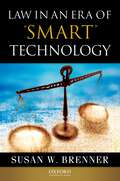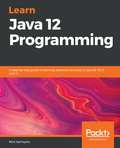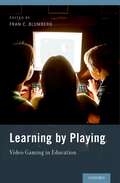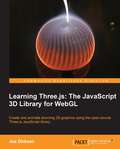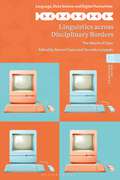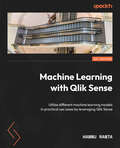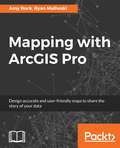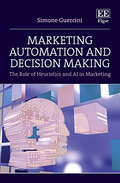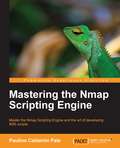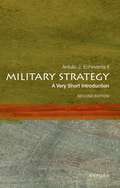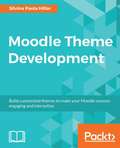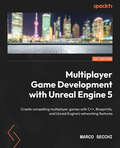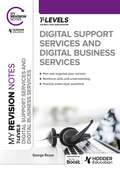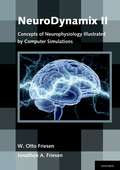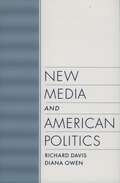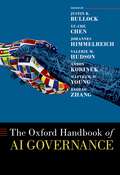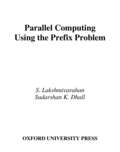- Table View
- List View
Learn Java 12 Programming: A Step-by-step Guide To Learning Essential Concepts In Java Se 10, 11, And 12
by Nick SamoylovLearning Geospatial Analysis with Python: Unleash the power of Python 3 with practical techniques for learning GIS and remote sensing
by Joel LawheadHarness the powerful Python programming language to navigate the realms of geographic information systems, remote sensing, topography, and more, while embracing a guiding framework for effective geospatial analysisKey FeaturesCreate GIS solutions using the new features introduced in Python 3.10Explore a range of GIS tools and libraries, including PostGIS, QGIS, and PROJIdentify the tools and resources that best align with your specific needsPurchase of the print or Kindle book includes a free PDF eBookBook DescriptionGeospatial analysis is used in almost every domain you can think of, including defense, farming, and even medicine. In this special 10th anniversary edition, you'll embark on an exhilarating geospatial analysis adventure using Python. This fourth edition starts with the fundamental concepts, enhancing your expertise in geospatial analysis processes with the help of illustrations, basic formulas, and pseudocode for real-world applications. As you progress, you’ll explore the vast and intricate geospatial technology ecosystem, featuring thousands of software libraries and packages, each offering unique capabilities and insights. This book also explores practical Python GIS geospatial applications, remote sensing data, elevation data, and the dynamic world of geospatial modeling. It emphasizes the predictive and decision-making potential of geospatial technology, allowing you to visualize complex natural world concepts, such as environmental conservation, urban planning, and disaster management to make informed choices. You’ll also learn how to leverage Python to process real-time data and create valuable information products. By the end of this book, you'll have acquired the knowledge and techniques needed to build a complete geospatial application that can generate a report and can be further customized for different purposes.What you will learnAutomate geospatial analysis workflows using PythonUnderstand the different formats in which geospatial data is availableUnleash geospatial tech tools to create stunning visualizationsCreate thematic maps with Python tools such as PyShp, OGR, and the Python Imaging LibraryBuild a geospatial Python toolbox for analysis and application developmentUnlock remote sensing secrets, detect changes, and process imageryLeverage ChatGPT for solving Python geospatial solutionsApply geospatial analysis to real-time data tracking and storm chasingWho this book is forThis book is for Python developers, researchers, or analysts who want to perform geospatial modeling and GIS analysis with Python. Basic knowledge of digital mapping and analysis using Python or other scripting languages will be helpful.
Learning Three.js: The Javascript 3d Library For Webgl
by Jos Dirksen“Learning Three.js is a hands-on guide which provides everything you need to start working with the powerful JavaScript library, and start creating awesome in-browser visualizations”.Learning Three.js is written for anyone looking to get started with Three.js, or looking to improve their skills with the popular js library. The book assumes some knowledge of javascript, but you don't need any knowledge of Three.js itself to follow the book.
Linguistics across Disciplinary Borders: The March of Data (Language, Data Science and Digital Humanities)
This volume highlights the ways in which recent developments in corpus linguistics and natural language processing can engage with topics across language studies, humanities and social science disciplines.New approaches have emerged in recent years that blur disciplinary boundaries, facilitated by factors such as the application of computational methods, access to large data sets, and the sharing of code, as well as continual advances in technologies related to data storage, retrieval, and processing. The “march of data” denotes an area at the border region of linguistics, humanities, and social science disciplines, but also the inevitable development of the underlying technologies that drive analysis in these subject areas.Organized into 3 sections, the chapters are connected by the underlying thread of linguistic corpora: how they can be created, how they can shed light on varieties or registers, and how their metadata can be utilized to better understand the internal structure of similar resources. While some chapters in the volume make use of well-established existing corpora, others analyze data from platforms such as YouTube, Twitter or Reddit. The volume provides insight into the diversity of methods, approaches, and corpora that inform our understanding of the “border regions” between the realms of data science, language/linguistics, and social or cultural studies.
Machine Learning with Qlik Sense: Utilize different machine learning models in practical use cases by leveraging Qlik Sense
by Hannu RantaMaster the art of machine learning by using the one-of-a-kind Qlik platform, and take your data analytics skills to the next levelKey FeaturesGain a solid understanding of machine learning concepts and learn to effectively define a problemExplore the application of machine learning principles within the Qlik platformApply your knowledge of ML to real-world scenarios with the help of practical examplesPurchase of the print or Kindle book includes a free PDF eBookBook DescriptionThe ability to forecast future trends through data prediction, coupled with the integration of ML and AI, has become indispensable to global enterprises. Qlik, with its extensive machine learning capabilities, stands out as a leading analytics platform enabling businesses to achieve exhaustive comprehension of their data. This book helps you maximize these capabilities by using hands-on illustrations to improve your ability to make data-driven decisions. You’ll begin by cultivating an understanding of machine learning concepts and algorithms, and build a foundation that paves the way for subsequent chapters. The book then helps you navigate through the process of framing machine learning challenges and validating model performance. Through the lens of Qlik Sense, you'll explore data preprocessing and analysis techniques, as well as find out how to translate these techniques into pragmatic machine learning solutions. The concluding chapters will help you get to grips with advanced data visualization methods to facilitate a clearer presentation of findings, complemented by an array of real-world instances to bolster your skillset. By the end of this book, you’ll have mastered the art of machine learning using Qlik tools and be able to take your data analytics journey to new heights.What you will learnFind out how to build practical machine learning solutions with the Qlik platformDevelop the skills needed to generate and verify machine learning models using the Qlik platformDiscover techniques used for preparing and investigating data to craft machine learning solutionsUnderstand how to transform real-world business problems into machine learning modelsExpand your potential to new use cases with data analyticsExplore advanced visualization techniques to make your models come aliveWho this book is forIf you’re interested in data and analytics and are looking to extend your skillset to machine learning, this book is for you. Basic working knowledge of data, preferably with Qlik tools, will help you get started with this book. This is an excellent guide for anyone who wants to start using machine learning as part of their data analytics journey.
Mapping with ArcGIS Pro: Design accurate and user-friendly maps to share the story of your data
by Ryan Malhoski Amy RockImplementing the ArcGIS Pro technique to design accurate, user friendly maps and making appropriate cartographic decisionsAbout This BookBuild visually stunning and useful maps;Understand the cartographic workflows and the decisions you must take before creating the map;Learn to create appropriate map elements and layout designsUse the ArcGIS Online's Smart Mapping technique to create clear webmapsWho This Book Is ForIf you are a GIS analyst or a Map designer who would like to create and design a map with ArcGIS Pro then this book is for you. A basic GIS knowledge is assumed.What You Will LearnUsing ArcGIS Pro to create visually stunning maps and make confident cartographic decisionsLeverage precise layout grids that will organize and guide the placement of map elementsMake appropriate decisions about color and symbolsCritically evaluate and choose the perfect projection for your dataCreate clear webmaps that focus the reader's attention using ArcGIS Online's Smart Mapping capabilitiesIn DetailArcGIS Pro is a geographic information system for working with maps and geographic information. This book will help you create visually stunning maps that increase the legibility of the stories being mapped and introduce visual and design concepts into a traditionally scientific, data-driven process. The book begins by outlining the steps of gathering data from authoritative sources and lays out the workflow of creating a great map. Once the plan is in place you will learn how to organize the Contents Pane in ArcGIS Pro and identify the steps involved in streamlining the production process. Then you will learn Cartographic Design techniques using ArcGIS Pro's feature set to organize the page structure and create a custom set of color swatches. You will be then exposed to the techniques required to ensure your data is clear and legible no matter the size or scale of your map. The later chapters will help you understand the various projection systems, trade-offs between them, and the proper applications of them to make sure your maps are accurate and visually appealing. Finally, you will be introduced to the ArcGIS Online ecosystem and how ArcGIS Pro can utilize it within the application. You will learn Smart Mapping, a new feature of ArcGIS Online that will help you to make maps that are visually stunning and useful.By the end of this book, you will feel more confident in making appropriate cartographic decisions.Style and approachThe book takes a pragmatic approach, showing various methods to create visually stunning maps.
Marketing Automation and Decision Making: The Role of Heuristics and AI in Marketing
by Simone GuerciniThe ever-evolving marketing technologies now include the extensive use of advanced AI with important implications for the decision making processes of both marketers and consumers. This detailed and insightful book rigorously examines the role of heuristics and marketers’ decision making within the industry’s growing utilisation of AI.Simone Guercini analyses over a decade of research, arguing that heuristics remain an important behavioural indicator despite complex data-driven models now characterising marketers’ decision making. Key examples of heuristics within marketing automation are referenced, including customer clustering, recommendation systems and programmatic advertising. Marketing Automation and Decision Making convincingly asserts that technological tools which adopt functional heuristics have the potential to integrate AI into marketing competences without replacing human capabilities, instead using machine capabilities to support and augment human capacity with highly beneficial outcomes.This innovative and forward-thinking book will be a fascinating read for students and academics interested in marketing, social science, social policy, psychology, AI and cognitive science. Marketing scholars and practitioners will also find this a highly interesting read.
Mastering Adobe Photoshop Elements: Bring out the best in your images using Adobe Photoshop Elements 2024
by Robin NicholsTake complete control of all your image-editing ambitions using this beautifully illustrated, easy-to-understand, jargon-free guide on Photoshop Elements 2024 packed with best practices and expert insights.Key FeaturesComprehensive coverage of Adobe Photoshop Elements 2024, including new AI-powered tools and advanced featuresPractical guidance on photo organization, editing, and sharing, with an emphasis on creative and professional techniquesRich, illustrative content with updated examples, tutorials, and mini creative projectsBook DescriptionDive into the world of digital photo editing with this latest edition, crafted by Robin Nichols, a seasoned photographer and digital imaging expert, which brings the latest Photoshop Elements 2024 to your fingertips. With a unique blend of in-depth tutorials and practical applications, this book is an essential resource for photographers at all levels. It introduces new features like Dark Mode, Match Color, and Photo Reels, along with advanced techniques like layering and artistic effects. The book also addresses common user feedback from previous editions, ensuring a refined and user-friendly experience. Elements 2024 extends its AI capabilities by simplifying complex editing processes. Learn to stitch widescreen panoramas, remove people from backgrounds, de-focus backgrounds, re-compose images, and even create a range of calendars and greeting cards for your friends and family. Take your prowess to the next level by learning how to correct optical distortion, re-shape images, exploit layers, layer masking, and sharpening techniques—create the perfect picture or imaginative fantasy illustration. You’ll also learn the online realms of animation, video creation, and third-party plug-ins. By the end of this book, you'll learn how to leverage the incredible features of Photoshop Elements 2024 with complete confidence.What you will learnMaster new features in Photoshop Elements 2024, including AI-powered tools and one-click fixes on mobileCreate captivating photo collages, digital paintings, and graphic designsEfficiently organize your photo collections for easy access and managementEnhance your social media presence with professionally edited photos and artworksEmploy advanced layer techniques for more powerful and immersive illustrationsGain comprehensive knowledge to become a proficient Photoshop Elements userWho this book is for"Mastering Adobe Photoshop Elements - 6th Edition" is perfect for photographers of all skill levels - from hobbyists to professionals. Whether you are new to photo editing or looking to upgrade your skills with the latest Photoshop Elements features, this book offers valuable insights and guidance.
Mastering Kotlin for Android 14: Build powerful Android apps from scratch using Jetpack libraries and Jetpack Compose
by Harun WangerekaAccelerate your Android development journey by mastering the latest Kotlin techniques and libraries to build robust appsKey FeaturesApply best practices and industry-essential skills used by Google Developer ExpertsFind out how to publish, monitor, and improve your app metrics on the Google Play StoreLearn how to debug issues, detect leaks, inspect network calls, and inspect your app’s local databasePurchase of the print or Kindle book includes a free PDF eBookBook DescriptionWritten with the best practices, this book will help you master Kotlin and use its powerful language features, libraries, tools, and APIs to elevate your Android apps. As you progress, you'll use Jetpack Compose and Material Design 3 to build UIs for your app, explore how to architect and improve your app architecture, and use Jetpack Libraries like Room and DataStore to persist your data locally. Using a step-by-step approach, this book will teach you how to debug issues in your app, detect leaks, inspect network calls fired by your app, and inspect your Room database. You'll also add tests to your apps to detect and address code smells. Toward the end, you’ll learn how to publish apps to the Google Play Store and see how to automate the process of deploying consecutive releases using GitHub actions, as well as learn how to distribute test builds to Firebase App Distribution. Additionally, the book covers tips on how to increase user engagement. By the end of this Kotlin book, you’ll be able to develop market-ready apps, add tests to their codebase, address issues, and get them in front of the right audience.What you will learnBuild beautiful, responsive, and accessible UIs with Jetpack ComposeExplore various app architectures and find out how you can improve themPerform code analysis and add unit and instrumentation tests to your appsPublish, monitor, and improve your apps in the Google Play StorePerform long-running operations with WorkManager and persist data in your appUse CI/CD with GitHub Actions and distribute test builds with Firebase App DistributionFind out how to add linting and static checks on CI/CD pipelinesWho this book is forIf you’re an aspiring Android developer or an Android developer working with Java, then this book is for you. Basic Java programming skills are a must if you want to fully utilize the techniques and best practices showcased in this book.
Mastering the Nmap Scripting Engine
by Paulino Calderon PaleIf you want to learn to write your own scripts for the Nmap Scripting Engine, this is the book for you. It is perfect for network administrators, information security professionals, and even Internet enthusiasts who are familiar with Nmap.
Microsoft Azure Fundamentals Certification and Beyond: A complete AZ-900 exam guide with online mock exams, flashcards, and hands-on activities
by Steve MilesAdvance your career by learning how to apply Azure Fundamentals effectively with this comprehensive guide, accompanied by web-based tools such as mock exams, flashcards, and hands-on activitiesKey FeaturesMaster the fundamentals of Azure through a comprehensive exploration of compute, network, and storage servicesLearn essential tools and strategies for securing, governing, and administering Azure effectivelyUse the mobile-friendly bonus website that comes with the book to gain ample practice on the goBook DescriptionMicrosoft Azure Fundamentals Certification and Beyond, Second Edition, combines the comprehensive cloud fundamentals book with Packt’s powerful exam training platform, offering a holistic learning experience designed to help you not just ace the AZ-900 exam but also apply that knowledge to excel in your career. Guiding you in building robust foundational knowledge of the Microsoft Azure cloud platform, this book helps you prepare for the AZ-900 exam confidently. The online content, included with every purchase, will help you memorize key concepts and assess your exam readiness. Starting with an introduction to cloud computing and its advantages, the book systematically guides you through Azure architecture and services before progressing to management and governance within Azure. The online platform unlocks unlimited access to mock exams with exam-like timers, detailed solutions for each question, interactive flashcards, exam tips, and interactive activities—all accessible from your computer, tablet, and smartphone. By the end of this book, you’ll be well prepared to pass the AZ-900 exam and have the foundational knowledge to delve into advanced cloud concepts.What you will learnBecome proficient in foundational cloud conceptsDevelop a solid understanding of core components of the Microsoft Azure cloud platformGet to grips with Azure’s core services, deployment, and management toolsImplement security concepts, operations, and posture managementExplore identity, governance, and compliance featuresGain insights into resource deployment, management, and monitoringWho this book is forThis Azure fundamentals book is for individuals with technical or non-technical backgrounds who want to learn and explore the field of cloud computing with Microsoft Azure. There are no prerequisites to get started, only a willingness to learn and explore cloud concepts and Microsoft Azure.
Military Strategy: Second Edition (Very Short Introductions)
by Antulio J. Echevarria IIDistilling the ideas of the greatest military theoreticians of history, including Sun Tzu, Niccol? Machiavelli, and Carl von Clausewitz, this clear and engaging Very Short Introduction presents a fascinating account of the "art of the general." Antulio J. Echevarria II highlights the dynamic relationship between the main elements of strategy: purpose, method, and means. Drawing on historical examples, he discusses the major types of military strategy and how emerging technologies are affecting them. This second edition has been updated throughout, and now includes an extended chapter on cyberwarfare which shows how the use of social media platforms to influence opinions on political views and manipulate populations to act in certain ways has evolved from an art to a science.
Modeling Religion: Simulating the Transformation of Worldviews, Lifeways, and Civilizations (Scientific Studies of Religion: Inquiry and Explanation)
by Wesley J. Wildman Professor of The F. LeRon ShultsWhat role has religion played in the major civilizational transformations associated with the Neolithic Revolution, the Axial Age, and Modernity? This book introduces new methodological tools and material insights for guiding conversations about these debates. The authors introduce a new branch of computational humanities, using computational modeling to simulate civilizational transformations. They integrate multiple theories across many disciplines, including the scientific study of religion, and evaluate the relative importance of those causal theories in processes of civilizational change. Materially, the book sheds new light on major debates among historians, archaeologists, and other social theorists on the role of religion within these major transitions.The book tackles the urgent question of what sort of civilizational transformations might be possible in a world where the influence and significance of religion continues to decline wherever technology, education, freedom, and cultural pluralism are most advanced.
Multiplayer Game Development with Unreal Engine 5: Create compelling multiplayer games with C++, Blueprints, and Unreal Engine's networking features
by Marco SecchiDiscover Unreal Engine 5’s networking techniques to create scalable and fully functional multiplayer game experiencesKey FeaturesDesign a captivating multiplayer game using networking techniques from this illustrated guideUnderstand how to use the Unreal Engine networking system with C++ and BlueprintsCarefully plan and develop an online experience from start to finishPurchase of the print or Kindle book includes a free PDF eBookBook DescriptionIf you’re fascinated by the immersive gaming experiences that enable multiple users to engage in collaborative or competitive gameplay, this Unreal Engine 5 game development book is for you. In this book, you’ll learn the foundational principles behind multiplayer games. Starting with a sample project, you’ll learn how to set up a networked system and make it work. Once the prototype of the project is functional, you’ll start adding game logic, including obstacles and AI opponents, to heighten the challenges and engagement, offering a captivating experience for players. Next, you’ll learn how to debug and optimize the project, before finally deploying the game build and integrating it with cloud services such as the Epic Online Services system. By the end of this book, you’ll have the confidence to develop and manage multiplayer experiences using the Unreal Engine environment, taking your newfound programming skills in your upcoming projects.What you will learnGet to grips with the basics of multiplayer game developmentUnderstand the main elements of a networked levelExplore Unreal multiplayer features such as replication, RPCs, relevancy, and rolesDebug and optimize code for improved game performanceDeploy the game on LAN or online platformsUse Epic Online Services to elevate the player experienceWho this book is forIf you are a game programmer, particularly an Unreal Engine developer, with little or no knowledge of video game networking systems and a passion for multiplayer games, this book will help you explore the subject in depth. Developers skilled in other game engines will find this book useful for understanding the principles of the Unreal multiplayer system, however, basic knowledge of Unreal Engine and C++ is strongly recommended.
Multiplayer Game Development with Unreal Engine 5: Create compelling multiplayer games with C++, Blueprints, and Unreal Engine's networking features
by Marco SecchiDiscover Unreal Engine 5’s networking techniques to create scalable and fully functional multiplayer game experiencesKey FeaturesDesign a captivating multiplayer game using networking techniques from this illustrated guideUnderstand how to use the Unreal Engine networking system with C++ and BlueprintsCarefully plan and develop an online experience from start to finishPurchase of the print or Kindle book includes a free PDF eBookBook DescriptionIf you’re fascinated by the immersive gaming experiences that enable multiple users to engage in collaborative or competitive gameplay, this Unreal Engine 5 game development book is for you. In this book, you’ll learn the foundational principles behind multiplayer games. Starting with a sample project, you’ll learn how to set up a networked system and make it work. Once the prototype of the project is functional, you’ll start adding game logic, including obstacles and AI opponents, to heighten the challenges and engagement, offering a captivating experience for players. Next, you’ll learn how to debug and optimize the project, before finally deploying the game build and integrating it with cloud services such as the Epic Online Services system. By the end of this book, you’ll have the confidence to develop and manage multiplayer experiences using the Unreal Engine environment, taking your newfound programming skills in your upcoming projects.What you will learnGet to grips with the basics of multiplayer game developmentUnderstand the main elements of a networked levelExplore Unreal multiplayer features such as replication, RPCs, relevancy, and rolesDebug and optimize code for improved game performanceDeploy the game on LAN or online platformsUse Epic Online Services to elevate the player experienceWho this book is forIf you are a game programmer, particularly an Unreal Engine developer, with little or no knowledge of video game networking systems and a passion for multiplayer games, this book will help you explore the subject in depth. Developers skilled in other game engines will find this book useful for understanding the principles of the Unreal multiplayer system, however, basic knowledge of Unreal Engine and C++ is strongly recommended.
My Revision Notes: Digital Support Services and Digital Business Services T Levels
by George RouseUnlock your full potential with this revision guide that will guide you through the knowledge and skills you need to succeed in the Digital Support Services and Digital Business Services T Level core and pathway core exams.- Plan your own revision and focus on the areas you need to revise with key content summaries and revision activities for every topic- Understand key terms you will need for the exam with user-friendly definitions and a glossary- Breakdown and apply scientific and mathematic principles with clear worked examples- Use the exam tips to clarify key points and avoid making typical mistakes- Test yourself with end-of-topic questions and answers and tick off each topic as you complete it- Get ready for the exam with tips on approaching the paper, and sample exam questions
New Media And American Politics
by Richard Davis Diana OwenNew Media and American Politicsis the first book to examine the effect on modern politics of the new media, which include talk radio, tabloid journalism, television talk shows, entertainment media, and computer networks. Davis and Owen discuss the new media's cultural environment, audience, and content, before going on to evaluate its impact on everything from elections to policy making to the old media itself.
Okta Administration Up and Running: Drive operational excellence with IAM solutions for on-premises and cloud apps
by HenkJan Vries Lovisa StjernlöfGet to grips with the fundamentals of Zero trust, IAM, and Okta, while learning how to carry out foundational configuration of your own tenants with the help of step-by-step instructionsKey FeaturesDiscover how to use Okta for complete identity and access management in your organizationExplore agentless desktop single sign-on, multifactor authentication, and lifecycle management for enhanced securityLearn about no-code and low-code automation functionalities, also known as Okta WorkflowsPurchase of the print or Kindle book includes a free PDF eBookBook DescriptionIdentity and access management (IAM) is a set of policies and technologies used to ensure an organization’s security, by carefully assigning roles and access to users and devices. This book will get you up and running with Okta, an IAM service that can help you manage both employees and customers. The book begins by helping you understand how Okta can be used as an IAM platform, before teaching you about Universal Directory and how to integrate with other directories and apps, as well as set up groups and policies for Joiner, Mover, and Leaver flows. This updated edition helps you to explore agentless desktop single sign-on (SSO) and multifactor authentication (MFA) solutions, and showing how to utilize Okta to meet NIST requirements. The chapters also walk you through Okta Workflows, low-/no-code automation functionalities, and custom API possibilities used to improve lifecycle management. Finally, you’ll delve into API access auditing and management, where you’ll discover how to leverage Advanced Server Access (ASA) for your cloud servers. By the end of this book, you’ll have learned how to implement Okta to enhance your organization's security and be able to use the book as a reference guide for the Okta certification exam.What you will learnGet a clear overview of Okta’s advanced featuresIntegrate Okta with directories and applications using hands-on instructionsGet practical recommendations on managing policies for SSO, MFA, and lifecycle managementDiscover how to manage groups and group rules for Joiner, Mover, Leaver events in Okta using examplesManage your Okta tenants using APIs and oversee API access with OktaSet up and manage your organization’s Okta environment, ensuring a secure IAM practiceFind out how to extend your Okta experience with Workflows and ASAWho this book is forIf you are an IT consultant, business decision-maker, system administrator, system and security engineer, or anyone looking to use Okta to plan, design, and implement identity and access management solutions, this book is for you. A basic understanding of authentication and authorization is necessary to understand the topics present in this book.
The Oxford Handbook of AI Governance (Oxford Handbooks)
As the capabilities of Artificial Intelligence (AI) have increased over recent years, so have the challenges of how to govern its usage. Consequently, prominent stakeholders across academia, government, industry, and civil society have called for states to devise and deploy principles, innovative policies, and best practices to regulate and oversee these increasingly powerful AI tools. Developing a robust AI governance system requires extensive collective efforts throughout the world. It also raises old questions of politics, democracy, and administration, but with the new challenges posed by AI's growing influence on markets, governing structures, international relations, healthcare, science, and political activism. The Oxford Handbook of AI Governance delineates the scope of these issues and addresses the key questions of AI governance. Across forty-nine chapters, organized in nine major sections, the Handbook covers the theoretical and ethical foundations of AI governance, different frameworks for developing a governance structure for AI, practical perspectives on AI governance in different policy domains, economic analyses of AI governance, and concrete lessons about the impact of AI governance domestically and internationally. Chapter authors come from a wide set of disciplines, areas of study, and cultural backgrounds, providing a global perspective on AI governance.
The Oxford Handbook of Video Game Music and Sound (Oxford Handbooks)
The music and sounds of video games have become an inescapable part of our world. Not only do these sonic elements profoundly shape the experiences of billions of players every day, but also the soundscapes of games have stretched out from our living rooms to encompass spaces as diverse as pinball arcades, concert halls, museums, and classrooms across the globe. Research on game music and sound is equally diverse-a vibrant, innovative, and multifaceted field that incorporates approaches from media studies, musicology, sound studies, music theory, psychology, and more. Drawing on the expertise of leading scholars and practitioners from around the globe, The Oxford Handbook of Video Game Music and Sound features nearly 50 chapters on topics ranging from the earliest pinball machines to the latest in virtual reality technology. The resulting volume provides both a comprehensive introduction to the study of game audio and an indispensable resource for experts.
